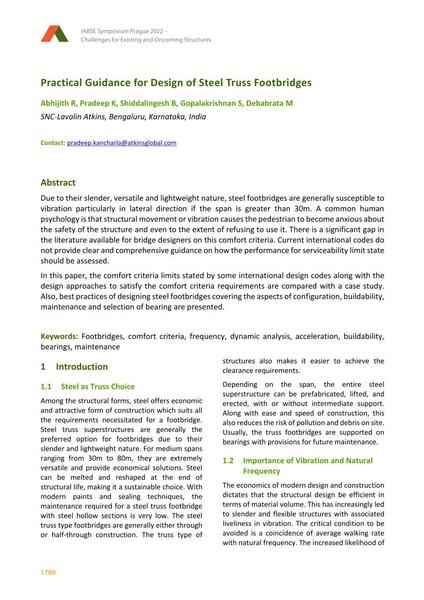Practical Guidance for Design of Steel Truss Footbridges

|
|
|||||||||||
Bibliographic Details
| Author(s): |
R. Abhijith
(SNC-Lavalin Atkins, Bengaluru, Karnataka, India)
K. Pradeep (SNC-Lavalin Atkins, Bengaluru, Karnataka, India) B. Shiddalingesh (SNC-Lavalin Atkins, Bengaluru, Karnataka, India) S. Gopalakrishnan (SNC-Lavalin Atkins, Bengaluru, Karnataka, India) M. Debabrata (SNC-Lavalin Atkins, Bengaluru, Karnataka, India) |
||||
|---|---|---|---|---|---|
| Medium: | conference paper | ||||
| Language(s): | English | ||||
| Conference: | IABSE Symposium: Challenges for Existing and Oncoming Structures, Prague, Czech Republic, 25-27 May 2022 | ||||
| Published in: | IABSE Symposium Prague 2022 | ||||
|
|||||
| Page(s): | 1780-1788 | ||||
| Total no. of pages: | 9 | ||||
| DOI: | 10.2749/prague.2022.1780 | ||||
| Abstract: |
Due to their slender, versatile and lightweight nature, steel footbridges are generally susceptible to vibration particularly in lateral direction if the span is greater than 30m. A common human psychology is that structural movement or vibration causes the pedestrian to become anxious about the safety of the structure and even to the extent of refusing to use it. There is a significant gap in the literature available for bridge designers on this comfort criteria. Current international codes do not provide clear and comprehensive guidance on how the performance for serviceability limit state should be assessed. In this paper, the comfort criteria limits stated by some international design codes along with the design approaches to satisfy the comfort criteria requirements are compared with a case study. Also, best practices of designing steel footbridges covering the aspects of configuration, buildability, maintenance and selection of bearing are presented. |
||||
| Keywords: |
footbridges acceleration Bearings comfort criteria maintenance dynamic analysis frequency buildability
|
||||
| Copyright: | © 2022 International Association for Bridge and Structural Engineering (IABSE) | ||||
| License: | This creative work is copyrighted material and may not be used without explicit approval by the author and/or copyright owner. |
||||



